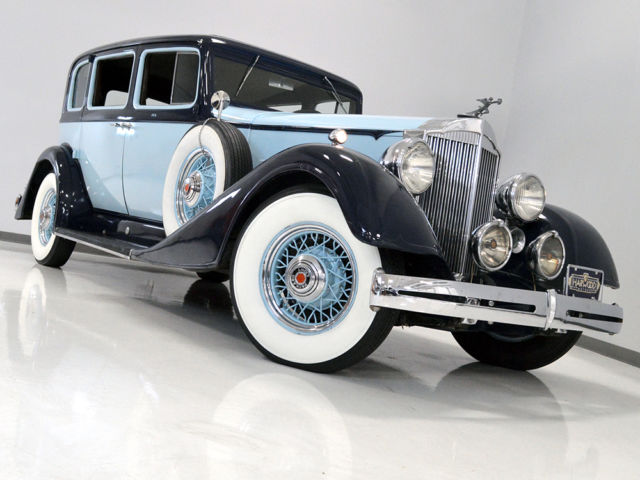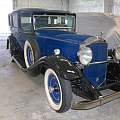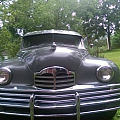In terms of pre-war Classic cars, few names stand as tall as Packard. 1934 Packards in particular are the most popular year and marque in the Classic Car Club of America, and they perfectly epitomize the best virtues of the Classic Era: power, grace, luxury, and engineering. Perhaps that’s why their survival rate is so high. 1934 also offered a vast array of chassis, engine, and body combinations, with the 1100 at the bottom end, available only as a 4-door sedan on a 129-inch wheelbase, all the way up to custom long-wheelbase 1108 Twelve models with bespoke coachwork. The Eight was Packard’s best seller, with the model 1101 being the most popular and offering the widest array of body styles. Sitting on a 137-inch wheelbase and powered by Packard’s famous 320 cubic inch straight-8 powerplant, it provided luxury, performance, and comfort for the well-heeled who perhaps didn’t want to advertise their status quite so loudly.
This handsome 1934 Packard 1101 Eight 5-passenger sedan is one of those great finds that you always hope you’ll discover. A mostly original car with a single repaint perhaps in the 1960s or 70s, it remains fully functional and usable, yet carries a reasonable price tag. If you’ve longed for a ’34 Packard (and who hasn’t?), this is a great find.
The two-tone blue paint combines traditional Packard Blue for the fenders and trim, with light blue bodywork that looks attractive without diminishing the car’s impressive size. It must have been an excellent job when it was done, because it’s holding up quite well, with very few age-related issues and certainly no signs of bad prep or inferior bodywork underneath. It’s been driven and toured for decades, so there are nicks and scratches and the area around the cowl where the hood fits has some scratches, but overall it presents quite well for a car that has never been apart. We’re not sure if the two-tone blue combination is original to the car (we suspect it was originally black, as that’s the color on the firewall), but it’s attractive and sporting, giving the car a longer, leaner look than its more conservative brothers. All four doors open and close with the kind of ka-CHUNK sound that is so pleasing in old cars of this vintage, and the hood snugs down easily. The running board rubber is probably original and I don’t believe it is reproduced, so we’ve tried to moisturize it to protect it, which is what I’d recommend you do as well. The chrome is a combination of original and re-plated parts, with the bumpers and headlight buckets being quite nice and things like the grille shell and taillight housings showing some very minor micro-blisters that indicate 1934 chrome. Nothing stands out as too nice or too deteriorated, and it’s worth noting that the car includes two hood ornaments, the current “Lady with Donut” that’s installed, plus a simple chrome cap that was probably standard equipment.
The interior is unquestionably original. Every soft surface is wrapped in dark olive green Bedford cord that gives it an understated elegance. Obviously there’s some heavy wear on the driver’s seat, with a few splits and thin spots, but the rest of the interior is very presentable, particularly the back seat area. We searched for the correct fabric to have the front seat area reupholstered, but were not successful in finding the right stuff (yes, we tried that guy, and that company, and the company you used—we even tried suppliers in Europe. We really tried!). Instead of reupholstering the entire interior and erasing all that originality, and perhaps choosing a color and material that wouldn’t match the new owner’s tastes, we simply cleaned it up. There’s no strange odor and the seats are firm and comfortable enough for touring, and we’ll let the next owner decide how to proceed. The original gauges are simply beautiful and they are all functional save for the fuel gauge and the clock, which isn’t unexpected. They all light up brightly with the headlights and the slender needles move back and forth as they monitor the engine’s vitals. The steering wheel is in excellent condition and the headlight controls, hand throttle, and horn all work correctly. Overhead, the headliner is in exceptional shape, so I’d hesitate to replace it, and we have two newly rebuilt vacuum wiper motors ready to be installed. Even the dome light works!
The engine is Packard’s famous 320 cubic inch straight-8, which in 1934, made 120 horsepower. It’s silky smooth and has impressive low-end torque, so you almost don’t have to shift at all around town—it’ll pull a stop sign in high gear. It was rebuilt a few years ago and more recently was treated to a valve job, and the head and exhaust manifold were painted at the same time. The carburetor and fuel pump were rebuilt and the gas tank was cleaned out, making it a reliable runner today. The automatic choke has been deactivated and is replaced by a manual knob on the dash, but it only needs it when it’s ice cold. Pull it out about ¾ of an inch, open the throttle a bit, and push the button and it springs to life easily, settling into an even idle. On the road, it pulls eagerly and cruises comfortably at 45-50 MPH, with bursts of up to 60 MPH possible without much strain. It makes plenty of oil pressure and stays below 180 degrees even in 90-degree weather. There’s a nice 8-cylinder grumble, but if I were making a to-do list for this car, I would replace the exhaust with a correct setup because I think a Packard should whisper more than this one does, though it’s hardly noisy.
By 1934, Packard had adopted synchromesh across the board, so gear changes are light and easy with no clashing or other issues. The clutch is relatively recent and save for some light chatter when it’s cold, it’s working well. It appears that the chassis is entirely original and a bit grungy, but it’s certainly not rusty and all the original components are there, including the adjustable shocks and vacuum brake booster. It appears that the rear shocks are newer, but we have not been able to discern if the adjustable ride control is operational—is there a lot of difference between settings or not? It’s hard to say without attributing some of it to the placebo effect. The brakes were serviced in the not-too-distant past, although the vacuum assist is not currently operational, so the pedal takes a bit of effort. Steering is good, the car tracks straight, and hums down the road easily thanks to 4.36 gears out back. New 17-inch Lester wide whitewall tires have just been fitted and have less than 200 miles on them, so it’s ready to tour.
Only 5120 Packard Eights were built in 1934, so it’s easy to understand why they’re so appealing today. This is a fantastic usable tour car that can be upgraded along the way, and as a ’34 Packard, it will always be on collectors’ list of must-have automobiles. It’s handsome, mechanically sorted, and ready to enjoy, and the price is certainly right. Call today!

 1932 Packard 901 straight 8 -Runs and drives great- Ready to tour-
1932 Packard 901 straight 8 -Runs and drives great- Ready to tour-
 1948 Packard Super Eight 327 Cubic Inch Flat Head
1948 Packard Super Eight 327 Cubic Inch Flat Head